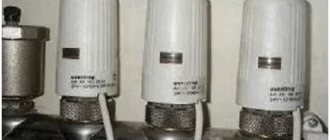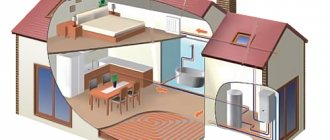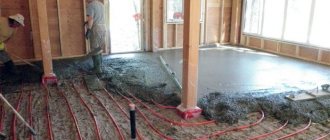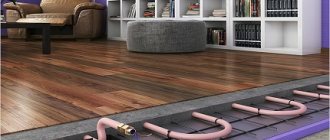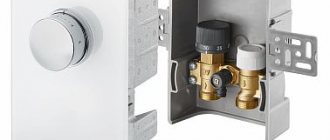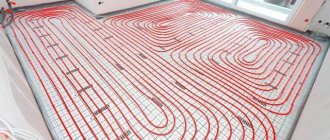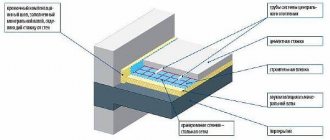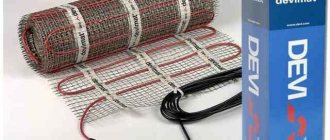There are no difficulties with adjusting the temperature of an electric heated floor. All you need is to install a temperature sensor that takes readings of the screed or air in the room and connect it to an electric thermostat. In this case, the thermostat simply turns off the power when the set temperature is reached. The thermostat for water heated floors works on the same principle, only it turns off the power to the servo drive. But everything is not so simple, there are several types of thermostats, servos and temperature sensors, which are sometimes incompatible. You need to select and connect the equipment correctly. More on this later.
Options for adjusting the temperature of water heated floors
Three-way valve with manual adjustment of coolant temperature.
You can regulate the degree of heating of the coolant in the low-temperature water circuit in two ways:
- manually;
- automated.
At the same time, there are two schemes for connecting a heated floor to a thermostat - this is through a manifold assembly or a three-way (two-way) valve. In the second case, the adjustment consists of changing the proportion of the feed and return mixture.
You can also regulate the temperature using shut-off valves on the comb. We turned it a few turns, waited until the temperature in the room leveled out, and if the result was not satisfactory, we made changes. The process takes a lot of time, and besides, it is very difficult to accurately select the required temperature, and given that the weather is constantly changing, it is completely impossible. Installing a manually controlled floor heating thermostat is cheaper, but there is more hassle with it.
There are two options for connecting a heated floor to a thermostat - through a manifold and through a three-way valve.
Another thing is the automated method of controlling the temperature of the coolant. Regardless of the method of connecting the underfloor heating pipes (via a manifold or a three-way valve). The coolant temperature is adjusted by a servo drive. It, in turn, is connected to a thermostat, which takes readings of the air or screed temperature through sensors. All you need in this case is simply to set the required heating mode.
Connecting a thermostat to electric heated floors
Electric heated floors are made using a high-resistance heating cable or infrared film. They are laid on a specially prepared base, after which the floor is screeded and the finishing coating is laid.
Thermostat connection technology:
- Before installing the floor, it is necessary to determine the location where the thermostat will be located and plan its connection to the electrical network. To connect the thermostat, a voltage of 220 V AC is required, that is, you can connect it to a regular outlet or to a separate cable through a circuit breaker.
- When laying the floor, choose a location for the temperature sensor. It should be located near the thermostat, on an area of the floor free from furniture.
Thermostat installation diagram
- For infrared floors, the sensor is placed on the reverse side of the film and connected to the wires going to the thermostat.
- For cable heated floors poured with concrete screed, the sensor must be placed in a metal corrugated pipe, insulating it from concrete. This measure is necessary for easy removal and replacement of the sensor in the event of its failure. A sensor embedded in concrete cannot be easily removed. The pipe is led to the wall on which the thermostat is installed.
- After laying the floor, begin installing the regulator. In the selected location, prepare a recess in the wall according to the dimensions of the built-in thermostat housing or make markings for attaching the overhead thermostat. Remove the front panel and secure the regulator in place.
- Compare the permissible switching power of the thermostat contacts with the power of the heating cable or infrared floor. If it is less, an additional magnetic starter with a coil rating of ~220V is installed. In this case, the heating cable circuit is connected to a 220 V power supply through the contacts of the magnetic starter, and the starter coil circuit is connected to the output from the thermostat.
- If the switching power of the thermostat contacts is sufficient, then the heating cable is connected directly to the output from the thermostat.
- Connect the sensor circuit to the terminals specified in the passport or instructions.
- Connect the 220 V power supply to the appropriate terminals: they are usually designated as L or F - phase and N - zero. Phasing must be observed. You can determine it by the color of the wire: if the cable is new and laid according to the rules, then the phase wire has black, brown or white insulation, and the neutral wire has blue insulation. If you connect the thermostat to a common outlet, the phase is found using a voltage indicator or an indicator screwdriver.
Connecting the thermostat
- Check the functionality of the thermostat:
- 220 V power supply;
- Set the minimum temperature value on the thermostat;
- Turn on the floor heating with a toggle switch;
- Change the temperature mode to maximum by turning the knob or using buttons - a click should be heard, notifying that the heating circuit is closed.
What types of thermostats are there?
Electronic, programmable thermostat.
All thermostats operate from the mains. The only difference is the temperature control method. There are electronic and mechanical thermostats for heated floors. Electronic ones are divided into programmable and non-programmable. The advantages of programmable ones are that you can set different temperatures for different times of the day and set a plan for the heating system to operate for the week.
All thermostats operate as a switch, that is, they close and open the network. The factor that motivates action is the readings of a temperature sensor, which can be built into the housing or located remotely. There are thermostats to which you can connect several sensors. If the sensor is built-in, then when installing the water heated floor regulator, the following rules must be observed:
- height 1.5 m;
- do not place near windows and doors (there is a draft there);
- do not place in the sun;
- Do not install above the heat exchanger or under the air conditioner.
Also, the temperature controller for the heated floor must be suitable for the servo drive. Depending on the type of thermostat, it can work to close the network when the temperature drops or rises. In addition, there are models that send signals to several devices at once: a servo drive and an electric circulation pump.
A new product is radio thermostats that transmit signals wirelessly to a special control unit, which is installed in the manifold box. Wires go from this block to connect servos, a computer, and a WI-FI router. Thus, you can control the operation of the heated floor using your smartphone when you are within reach of WI-FI. In addition, it is possible to control the low-temperature heating system via the Internet.
It is difficult to answer unequivocally which insulation is better for a ventilated façade. If it’s cheaper, then mineral wool, and if the price doesn’t matter, then polyurethane foam.
If the bees are not insulated in time in the spring, the colony may die. Next here.
Types of thermostats
A thermostat (thermostat) is a device that ensures that a given temperature is maintained within certain limits.
In a heated floor system , it determines the temperature based on signals from a sensor located in the screed between the heating elements. This device then compares the sensor readings with the temperature set by the user.
If the temperature exceeds the set temperature, the thermostat turns off the heating . When the temperature drops below the set limit, the device turns on the current again. A household thermostat maintains temperature with an accuracy of ±1°C.
There are two types of thermostats :
- mechanical;
- electronic.
Mechanical ones are equipped with a rotary handle, with which you set the desired temperature. The current in it is switched on and off by an electromechanical relay, which emits a characteristic click during operation.
Electronic thermostats have no mechanical moving parts. Switching the current on and off in them is carried out by an electronic relay that does not make sounds. Some of these devices have push-button control and a liquid crystal display panel, which indicates the set temperature, the current temperature and the operating mode (heating or cooling).
Most modern thermostats have touch-sensitive displays and no buttons. Mechanical thermostats are not programmable. They constantly maintain the temperature set by turning the knob.
Electronic devices are divided into two groups:
- without program control (maintain a certain temperature);
- programmable (automatically change the heating mode during the day according to a given program).
Programmable thermostats reduce heating costs regardless of the user's forgetfulness.
What is a servo drive
Servo drives automatically shut off the coolant flow.
The servo is a head that screws onto a manifold feed comb, a three-way valve, or even directly onto the battery. In our case, only the first two options are relevant. The thermal head is connected to the power supply and a thermostat installed in the room. There is a bellows inside it that regulates the flow of coolant. A bellows is an elastic cylinder; inside it there is a liquid that expands when heated, and the bellows itself increases in volume, blocking the flow path. Heating elements are placed around the bellows, which begin to work when the contact on the thermostat is closed.
The servo drive is:
- normal closure - when disconnected from the power supply, the path to the coolant is blocked;
- normally open - when disconnected from the power supply, the path to the coolant is open.
In a modern heating system, the boiler and circulation pump are energy-dependent. If you do not have backup power installed (uninterruptible heating), then if there is a power outage, the heating will stop. Therefore, basically everyone uses normally closed servos and installs a UPS.
Rockwool mineral wool insulating cylinders made of basalt are even suitable for insulating chimneys.
Read about why you need to choose non-combustible insulation for the facade in this article.
Putting the system together
So, let’s summarize everything we said about installing a heated floor thermostat. A thermostat is installed in the room, which works to close/open the servo drive network. The thermostat operates based on the readings of a temperature sensor, which controls the degree of heating of the air or screed. The thermostat and servomotor are interconnected and both are connected to the electrical network. It is optimal when an uninterruptible power supply is installed and each element for adjusting the heated floor is connected to the UPS through a switching unit.

